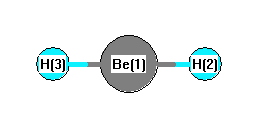Vibrational Frequencies calculated at CISD/6-311G*
| Mode Number |
Symmetry |
Frequency
(cm-1) |
Scaled Frequency
(cm-1) |
IR Intensities
(km mol-1) |
Raman Act
(Å4/u) |
Dep P |
Dep U |
|---|
| 1 |
Σg |
2011 |
1861 |
0.00 |
|
|
|
| 2 |
Σu |
2227 |
2060 |
226.01 |
|
|
|
| 3 |
Πu |
717 |
664 |
291.67 |
|
|
|
| 3 |
Πu |
717 |
664 |
291.67 |
|
|
|
Unscaled Zero Point Vibrational Energy (zpe) 2836.2 cm
-1
Scaled (by 0.9253) Zero Point Vibrational Energy (zpe) 2624.3 cm
-1
See section
III.C.1 List or set vibrational scaling factors
to change the scale factors used here.
See section
III.C.2
Calculate a vibrational scaling factor for a given set of molecules
to determine the least squares best scaling factor.
